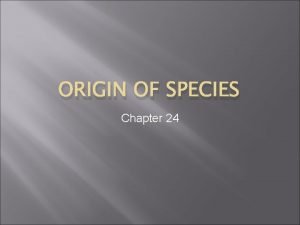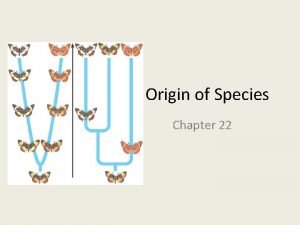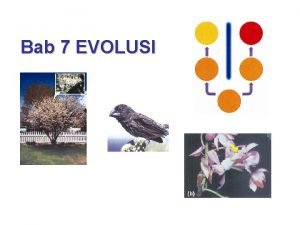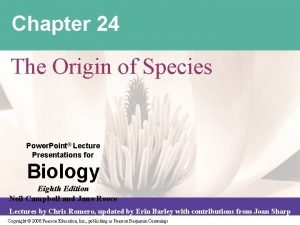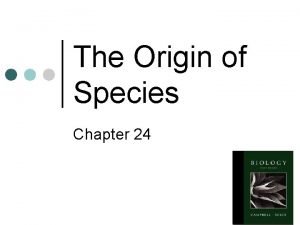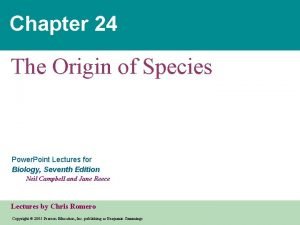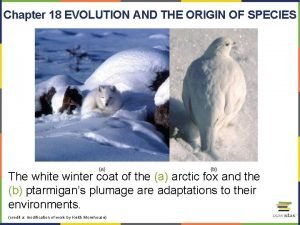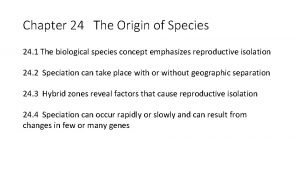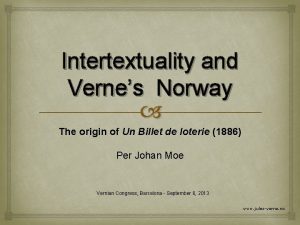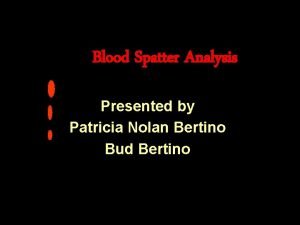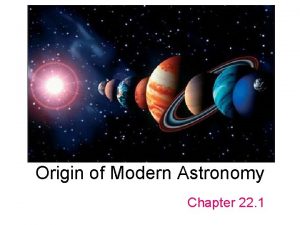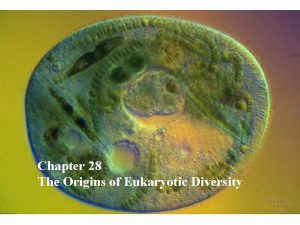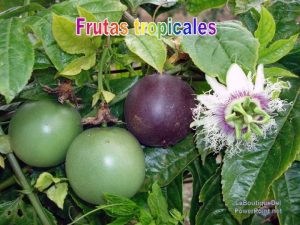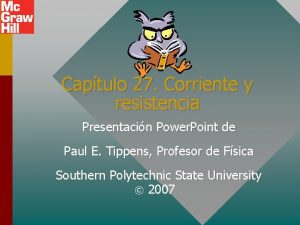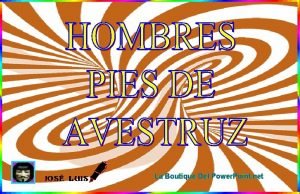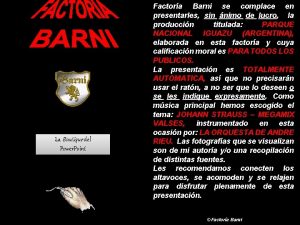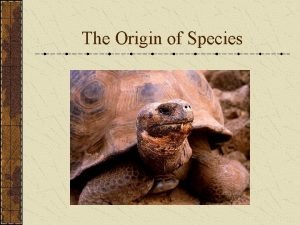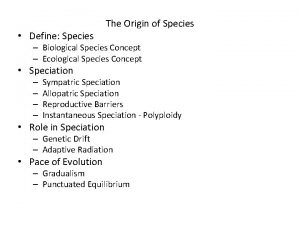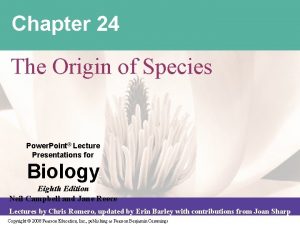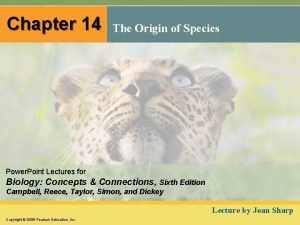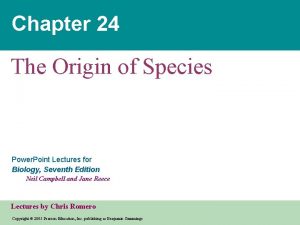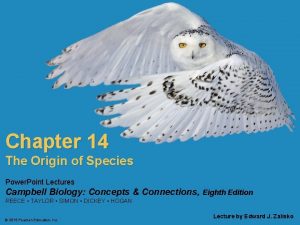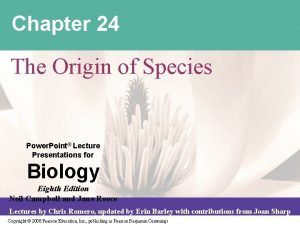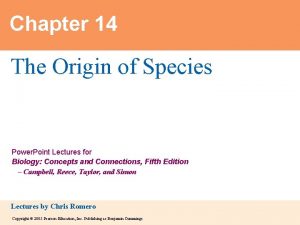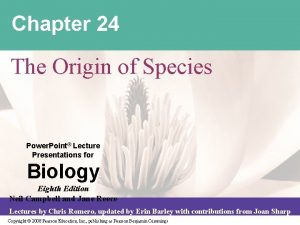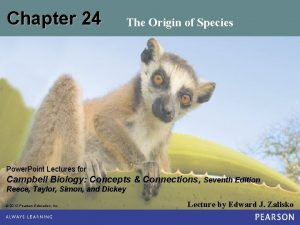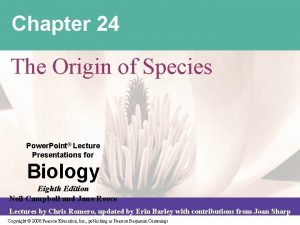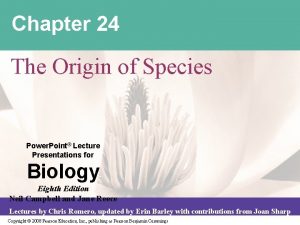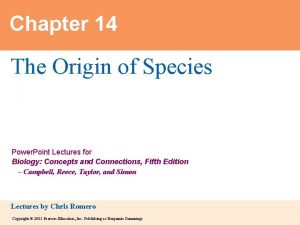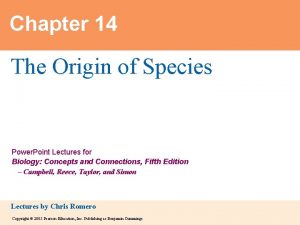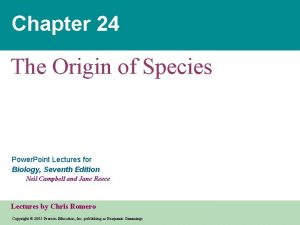Chapter 24 The Origin of Species Power Point













































































































- Slides: 109

Chapter 24 The Origin of Species Power. Point® Lecture Presentations for Biology Eighth Edition Neil Campbell and Jane Reece Lectures by Chris Romero, updated by Erin Barley with contributions from Joan Sharp Copyright © 2008 Pearson Education, Inc. , publishing as Pearson Benjamin Cummings

Overview: That “Mystery of Mysteries” • In the Galápagos Islands Darwin discovered plants and animals found nowhere else on Earth Video: Galápagos Tortoise Copyright © 2008 Pearson Education, Inc. , publishing as Pearson Benjamin Cummings

Fig. 24 -1

• Speciation, the origin of new species, is at the focal point of evolutionary theory • Evolutionary theory must explain how new species originate and how populations evolve • Microevolution consists of adaptations that evolve within a population, confined to one gene pool • Macroevolution refers to evolutionary change above the species level Macroevolution Copyright © 2008 Pearson Education, Inc. , publishing as Pearson Benjamin Cummings

Concept 24. 1: The biological species concept emphasizes reproductive isolation • Species is a Latin word meaning “kind” or “appearance” • Biologists compare morphology, physiology, biochemistry, and DNA sequences when grouping organisms Copyright © 2008 Pearson Education, Inc. , publishing as Pearson Benjamin Cummings

The Biological Species Concept • The biological species concept states that a species is a group of populations whose members have the potential to interbreed in nature and produce viable, fertile offspring; they do not breed successfully with other populations • Gene flow between populations holds the phenotype of a population together Copyright © 2008 Pearson Education, Inc. , publishing as Pearson Benjamin Cummings

Fig. 24 -2 (a) Similarity between different species (b) Diversity within a species

Fig. 24 -2 a (a) Similarity between different species

Fig. 24 -2 b (b) Diversity within a species

Fig. 24 -3 EXPERIMENT Example of a gene tree for population pair A-B Allele Gene flow event Population 1 B 2 A 3 A 4 A 5 B 6 B 7 B Allele 1 is more closely related to alleles 2, 3, and 4 than to alleles 5, 6, and 7. Inference: Gene flow occurred. Alleles 5, 6, and 7 are more closely related to one another than to alleles in population A. Inference: No gene flow occurred. RESULTS Pair of populations with detected gene flow Estimated minimum number of gene flow events to account for genetic patterns Distance between populations (km) A-B 5 340 K-L 3 720 A-C 2– 3 1, 390 B-C 2 1, 190 F-G 2 760 G-I 2 1, 110 C-E 1– 2 1, 310

Fig. 24 -3 a EXPERIMENT Example of a gene tree for population pair A-B Allele Population Gene flow event 1 B 2 A 3 A 4 A 5 B 6 B 7 B Allele 1 is more closely related to alleles 2, 3, and 4 than to alleles 5, 6, and 7. Inference: Gene flow occurred. Alleles 5, 6, and 7 are more closely related to one another than to alleles in population A. Inference: No gene flow occurred.

Fig. 24 -3 b RESULTS Pair of populations with detected gene flow Estimated minimum number of gene flow events to account for genetic patterns Distance between populations (km) A-B 5 340 K-L 3 720 A-C 2– 3 1, 390 B-C 2 1, 190 F-G 2 760 G-I 2 1, 110 C-E 1– 2 1, 310

Fig. 24 -3 c Grey-crowned babblers

Reproductive Isolation • Reproductive isolation is the existence of biological factors (barriers) that impede two species from producing viable, fertile offspring • Hybrids are the offspring of crosses between different species • Reproductive isolation can be classified by whether factors act before or after fertilization Copyright © 2008 Pearson Education, Inc. , publishing as Pearson Benjamin Cummings

• Prezygotic barriers block fertilization from occurring by: – Impeding different species from attempting to mate – Preventing the successful completion of mating – Hindering fertilization if mating is successful Copyright © 2008 Pearson Education, Inc. , publishing as Pearson Benjamin Cummings

• Habitat isolation: Two species encounter each other rarely, or not at all, because they occupy different habitats, even though not isolated by physical barriers Copyright © 2008 Pearson Education, Inc. , publishing as Pearson Benjamin Cummings

Fig. 24 -4 Prezygotic barriers Habitat Isolation Temporal Isolation Individuals of different species (a) Postzygotic barriers Behavioral Isolation Mechanical Isolation Gametic Isolation Mating attempt (c) (d) (e) (f) Reduced Hybrid Viability Reduced Hybrid Fertility Hybrid Breakdown Viable, fertile offspring Fertilization (g) (h) (i) (j) (b) (k) (l)

Fig. 24 -4 a Prezygotic barriers Habitat Isolation Temporal Isolation Individuals of different species (a) Mating attempt (c) (d) (b) Mechanical Isolation Behavioral Isolation (e) (f)

Fig. 24 -4 i Prezygotic barriers Gametic Isolation Postzygotic barriers Reduced Hybrid Viability Reduced Hybrid Fertility Hybrid Breakdown Viable, fertile offspring Fertilization (g) (h) (i) (j) (k) (l)

Fig. 24 -4 b Prezygotic barriers Habitat Isolation Individuals of different species Temporal Isolation Behavioral Isolation Mechanical Isolation Mating attempt

Fig. 24 -4 j Postzygotic barriers Prezygotic barriers Gametic Isolation Reduced Hybrid Viability Fertilization Reduced Hybrid Fertility Hybrid Breakdown Viable, fertile offspring

Fig. 24 -4 c (a) Water-dwelling Thamnophis

Fig. 24 -4 d (b) Terrestrial Thamnophis

• Temporal isolation: Species that breed at different times of the day, different seasons, or different years cannot mix their gametes Copyright © 2008 Pearson Education, Inc. , publishing as Pearson Benjamin Cummings

Fig. 24 -4 e (c) Eastern spotted skunk (Spilogale putorius)

Fig. 24 -4 f (d) Western spotted skunk (Spilogale gracilis)

• Behavioral isolation: Courtship rituals and other behaviors unique to a species are effective barriers Video: Albatross Courtship Ritual Video: Giraffe Courtship Ritual Video: Blue-footed Boobies Courtship Ritual Copyright © 2008 Pearson Education, Inc. , publishing as Pearson Benjamin Cummings

Fig. 24 -4 g (e) Courtship ritual of bluefooted boobies

• Mechanical isolation: Morphological differences can prevent successful mating Copyright © 2008 Pearson Education, Inc. , publishing as Pearson Benjamin Cummings

Fig. 24 -4 h (f) Bradybaena with shells spiraling in opposite directions

• Gametic isolation: Sperm of one species may not be able to fertilize eggs of another species Copyright © 2008 Pearson Education, Inc. , publishing as Pearson Benjamin Cummings

Fig. 24 -4 k (g) Sea urchins

• Postzygotic barriers prevent the hybrid zygote from developing into a viable, fertile adult: – Reduced hybrid viability – Reduced hybrid fertility – Hybrid breakdown Copyright © 2008 Pearson Education, Inc. , publishing as Pearson Benjamin Cummings

• Reduced hybrid viability: Genes of the different parent species may interact and impair the hybrid’s development Copyright © 2008 Pearson Education, Inc. , publishing as Pearson Benjamin Cummings

Fig. 24 -4 l (h) Ensatina hybrid

• Reduced hybrid fertility: Even if hybrids are vigorous, they may be sterile Copyright © 2008 Pearson Education, Inc. , publishing as Pearson Benjamin Cummings

Fig. 24 -4 m (i) Donkey

Fig. 24 -4 n ( j) Horse

Fig. 24 -4 o (k) Mule (sterile hybrid)

• Hybrid breakdown: Some first-generation hybrids are fertile, but when they mate with another species or with either parent species, offspring of the next generation are feeble or sterile Copyright © 2008 Pearson Education, Inc. , publishing as Pearson Benjamin Cummings

Fig. 24 -4 p (l) Hybrid cultivated rice plants with stunted offspring (center)

Limitations of the Biological Species Concept • The biological species concept cannot be applied to fossils or asexual organisms (including all prokaryotes) Copyright © 2008 Pearson Education, Inc. , publishing as Pearson Benjamin Cummings

Other Definitions of Species • Other species concepts emphasize the unity within a species rather than the separateness of different species • The morphological species concept defines a species by structural features – It applies to sexual and asexual species but relies on subjective criteria Copyright © 2008 Pearson Education, Inc. , publishing as Pearson Benjamin Cummings

• The ecological species concept views a species in terms of its ecological niche – It applies to sexual and asexual species and emphasizes the role of disruptive selection • The phylogenetic species concept: defines a species as the smallest group of individuals on a phylogenetic tree – It applies to sexual and asexual species, but it can be difficult to determine the degree of difference required for separate species Copyright © 2008 Pearson Education, Inc. , publishing as Pearson Benjamin Cummings

Concept 24. 2: Speciation can take place with or without geographic separation • Speciation can occur in two ways: – Allopatric speciation – Sympatric speciation Copyright © 2008 Pearson Education, Inc. , publishing as Pearson Benjamin Cummings

Fig. 24 -5 (a) Allopatric speciation (b) Sympatric speciation

Allopatric (“Other Country”) Speciation • In allopatric speciation, gene flow is interrupted or reduced when a population is divided into geographically isolated subpopulations Copyright © 2008 Pearson Education, Inc. , publishing as Pearson Benjamin Cummings

The Process of Allopatric Speciation • The definition of barrier depends on the ability of a population to disperse • Separate populations may evolve independently through mutation, natural selection, and genetic drift Copyright © 2008 Pearson Education, Inc. , publishing as Pearson Benjamin Cummings

Fig. 24 -6 A. harrisi A. leucurus

Evidence of Allopatric Speciation • Regions with many geographic barriers typically have more species than do regions with fewer barriers Copyright © 2008 Pearson Education, Inc. , publishing as Pearson Benjamin Cummings

Fig. 24 -7 Mantellinae (Madagascar only): 100 species Rhacophorinae (India/Southeast Asia): 310 species Other Indian/ Southeast Asian frogs 100 60 80 1 2 40 20 0 3 Millions of years ago (mya) 1 3 2 India Madagascar 88 mya 65 mya 56 mya

Fig. 24 -7 a Mantellinae (Madagascar only): 100 species Rhacophorinae (India/Southeast Asia): 310 species Other Indian/ Southeast Asian frogs 100 80 1 60 40 2 3 Millions of years ago (mya) 20 0

Fig. 24 -7 b 1 2 3 India Madagascar 88 mya 65 mya 56 mya

• Reproductive isolation between populations generally increases as the distance between them increases Copyright © 2008 Pearson Education, Inc. , publishing as Pearson Benjamin Cummings

Degree of reproductive isolation Fig. 24 -8 2. 0 1. 5 1. 0 0. 5 0 0 50 200 250 100 150 Geographic distance (km) 300

• Barriers to reproduction are intrinsic; separation itself is not a biological barrier Copyright © 2008 Pearson Education, Inc. , publishing as Pearson Benjamin Cummings

Fig. 24 -9 EXPERIMENT Initial population Some flies raised on starch medium Mating experiments after 40 generations Some flies raised on maltose medium RESULTS Female 9 8 20 Mating frequencies in experimental group Starch population 2 population 1 22 Starch population 1 population 2 Male Maltose Starch Female Starch Maltose 18 15 12 15 Mating frequencies in control group

Fig. 24 -9 a EXPERIMENT Initial population Some flies raised on starch medium Mating experiments after 40 generations Some flies raised on maltose medium

Fig. 24 -9 b RESULTS Female 9 8 20 Mating frequencies in experimental group Starch population 2 population 1 22 Starch population 1 population 2 Male Maltose Starch Female Starch Maltose 18 15 12 15 Mating frequencies in control group

Sympatric (“Same Country”) Speciation • In sympatric speciation, speciation takes place in geographically overlapping populations Copyright © 2008 Pearson Education, Inc. , publishing as Pearson Benjamin Cummings

Polyploidy • Polyploidy is the presence of extra sets of chromosomes due to accidents during cell division • An autopolyploid is an individual with more than two chromosome sets, derived from one species Copyright © 2008 Pearson Education, Inc. , publishing as Pearson Benjamin Cummings

Fig. 24 -10 -1 2 n = 6 4 n = 12 Failure of cell division after chromosome duplication gives rise to tetraploid tissue.

Fig. 24 -10 -2 2 n = 6 4 n = 12 Failure of cell division after chromosome duplication gives rise to tetraploid tissue. 2 n Gametes produced are diploid. .

Fig. 24 -10 -3 2 n = 6 4 n = 12 Failure of cell division after chromosome duplication gives rise to tetraploid tissue. 2 n Gametes produced are diploid. . 4 n Offspring with tetraploid karyotypes may be viable and fertile.

• An allopolyploid is a species with multiple sets of chromosomes derived from different species Copyright © 2008 Pearson Education, Inc. , publishing as Pearson Benjamin Cummings

Fig. 24 -11 -1 Species B 2 n = 4 Unreduced gamete with 4 chromosomes Meiotic error Species A 2 n = 6 Normal gamete n=3

Fig. 24 -11 -2 Species B 2 n = 4 Unreduced gamete with 4 chromosomes Meiotic error Species A 2 n = 6 Normal gamete n=3 Hybrid with 7 chromosomes

Fig. 24 -11 -3 Species B 2 n = 4 Unreduced gamete with 4 chromosomes Meiotic error Species A 2 n = 6 Normal gamete n=3 Hybrid with 7 chromosomes Unreduced gamete with 7 chromosomes Normal gamete n=3

Fig. 24 -11 -4 Species B 2 n = 4 Unreduced gamete with 4 chromosomes Meiotic error Species A 2 n = 6 Normal gamete n=3 Hybrid with 7 chromosomes Unreduced gamete with 7 chromosomes Normal gamete n=3 Viable fertile hybrid (allopolyploid) 2 n = 10

• Polyploidy is much more common in plants than in animals • Many important crops (oats, cotton, potatoes, tobacco, and wheat) are polyploids Copyright © 2008 Pearson Education, Inc. , publishing as Pearson Benjamin Cummings

Habitat Differentiation • Sympatric speciation can also result from the appearance of new ecological niches • For example, the North American maggot fly can live on native hawthorn trees as well as more recently introduced apple trees Copyright © 2008 Pearson Education, Inc. , publishing as Pearson Benjamin Cummings

Sexual Selection • Sexual selection can drive sympatric speciation • Sexual selection for mates of different colors has likely contributed to the speciation in cichlid fish in Lake Victoria Copyright © 2008 Pearson Education, Inc. , publishing as Pearson Benjamin Cummings

Fig. 24 -12 EXPERIMENT Normal light P. pundamilia P. nyererei Monochromatic orange light

Allopatric and Sympatric Speciation: A Review • In allopatric speciation, geographic isolation restricts gene flow between populations • Reproductive isolation may then arise by natural selection, genetic drift, or sexual selection in the isolated populations • Even if contact is restored between populations, interbreeding is prevented Copyright © 2008 Pearson Education, Inc. , publishing as Pearson Benjamin Cummings

• In sympatric speciation, a reproductive barrier isolates a subset of a population without geographic separation from the parent species • Sympatric speciation can result from polyploidy, natural selection, or sexual selection Copyright © 2008 Pearson Education, Inc. , publishing as Pearson Benjamin Cummings

Concept 24. 3: Hybrid zones provide opportunities to study factors that cause reproductive isolation • A hybrid zone is a region in which members of different species mate and produce hybrids Copyright © 2008 Pearson Education, Inc. , publishing as Pearson Benjamin Cummings

Patterns Within Hybrid Zones • A hybrid zone can occur in a single band where adjacent species meet • Hybrids often have reduced fitness compared with parent species • The distribution of hybrid zones can be more complex if parent species are found in multiple habitats within the same region Copyright © 2008 Pearson Education, Inc. , publishing as Pearson Benjamin Cummings

Fig. 24 -13 EUROPE Fire-bellied toad range Hybrid zone Fire-bellied toad, Bombina bombina 0. 99 Allele frequency (log scale) Yellow-bellied toad, Bombina variegata Yellow-bellied toad range 0. 9 0. 5 0. 1 0. 01 40 20 30 10 20 Distance from hybrid zone center (km)

Fig. 24 -13 a Yellow-bellied toad, Bombina variegata

Fig. 24 -13 b Fire-bellied toad, Bombina bombina

Fig. 24 -13 c Fire-bellied toad range Hybrid zone Allele frequency (log scale) Yellow-bellied toad range 0. 99 0. 5 0. 1 0. 01 40 20 10 0 30 20 10 Distance from hybrid zone center (km)

Hybrid Zones over Time • When closely related species meet in a hybrid zone, there are three possible outcomes: – Strengthening of reproductive barriers – Weakening of reproductive barriers – Continued formation of hybrid individuals Copyright © 2008 Pearson Education, Inc. , publishing as Pearson Benjamin Cummings

Fig. 24 -14 -1 Gene flow Population (five individuals are shown) Barrier to gene flow

Fig. 24 -14 -2 Isolated population diverges Gene flow Population (five individuals are shown) Barrier to gene flow

Fig. 24 -14 -3 Isolated population diverges Hybrid zone Gene flow Population (five individuals are shown) Hybrid Barrier to gene flow

Fig. 24 -14 -4 Isolated population diverges Hybrid zone Possible outcomes: Reinforcement OR Fusion Gene flow Population (five individuals are shown) Hybrid Barrier to gene flow OR Stability

Reinforcement: Strengthening Reproductive Barriers • The reinforcement of barriers occurs when hybrids are less fit than the parent species • Over time, the rate of hybridization decreases • Where reinforcement occurs, reproductive barriers should be stronger for sympatric than allopatric species Copyright © 2008 Pearson Education, Inc. , publishing as Pearson Benjamin Cummings

Fig. 24 -15 Sympatric male pied flycatcher 28 Number of females 24 Allopatric male pied flycatcher Pied flycatchers Collared flycatchers 20 16 12 8 4 (none) 0 Females mating Own Other with males from: species Sympatric males Own Other species Allopatric males

Fig. 24 -15 a Sympatric male pied flycatcher Allopatric male pied flycatcher

Fig. 24 -15 b 28 Number of females 24 Pied flycatchers Collared flycatchers 20 16 12 8 4 (none) 0 Other Females mating Own with males from: species Sympatric males Own Other species Allopatric males

Fusion: Weakening Reproductive Barriers • If hybrids are as fit as parents, there can be substantial gene flow between species • If gene flow is great enough, the parent species can fuse into a single species Copyright © 2008 Pearson Education, Inc. , publishing as Pearson Benjamin Cummings

Fig. 24 -16 Pundamilia nyererei Pundamilia pundamilia Pundamilia “turbid water, ” hybrid offspring from a location with turbid water

Stability: Continued Formation of Hybrid Individuals • Extensive gene flow from outside the hybrid zone can overwhelm selection for increased reproductive isolation inside the hybrid zone • In cases where hybrids have increased fitness, local extinctions of parent species within the hybrid zone can prevent the breakdown of reproductive barriers Copyright © 2008 Pearson Education, Inc. , publishing as Pearson Benjamin Cummings

Concept 24. 4: Speciation can occur rapidly or slowly and can result from changes in few or many genes • Many questions remain concerning how long it takes for new species to form, or how many genes need to differ between species Copyright © 2008 Pearson Education, Inc. , publishing as Pearson Benjamin Cummings

The Time Course of Speciation • Broad patterns in speciation can be studied using the fossil record, morphological data, or molecular data Copyright © 2008 Pearson Education, Inc. , publishing as Pearson Benjamin Cummings

Patterns in the Fossil Record • The fossil record includes examples of species that appear suddenly, persist essentially unchanged for some time, and then apparently disappear • Niles Eldredge and Stephen Jay Gould coined the term punctuated equilibrium to describe periods of apparent stasis punctuated by sudden change • The punctuated equilibrium model contrasts with a model of gradual change in a species’ existence Copyright © 2008 Pearson Education, Inc. , publishing as Pearson Benjamin Cummings

Fig. 24 -17 (a) Punctuated pattern Time (b) Gradual pattern

Speciation Rates • The punctuated pattern in the fossil record and evidence from lab studies suggests that speciation can be rapid • The interval between speciation events can range from 4, 000 years (some cichlids) to 40, 000 years (some beetles), with an average of 6, 500, 000 years Copyright © 2008 Pearson Education, Inc. , publishing as Pearson Benjamin Cummings

Fig. 24 -18 (a) The wild sunflower Helianthus anomalus H. anomalus Chromosome 1 Experimental hybrid H. anomalus Chromosome 2 Experimental hybrid H. anomalus Chromosome 3 Experimental hybrid Key Region diagnostic for parent species H. petiolaris Region diagnostic for parent species H. annuus Region lacking information on parental origin (b) The genetic composition of three chromosomes in H. anomalus and in experimental hybrids

Fig. 24 -18 a (a) The wild sunflower Helianthus anomalus

Fig. 24 -18 b H. anomalus Chromosome 1 Experimental hybrid H. anomalus Chromosome 2 Experimental hybrid H. anomalus Chromosome 3 Experimental hybrid Key Region diagnostic for parent species H. petiolaris Region diagnostic for parent species H. annuus Region lacking information on parental origin (b) The genetic composition of three chromosomes in H. anomalus and in experimental hybrids

Studying the Genetics of Speciation • The explosion of genomics is enabling researchers to identify specific genes involved in some cases of speciation • Depending on the species in question, speciation might require the change of only a single allele or many alleles Copyright © 2008 Pearson Education, Inc. , publishing as Pearson Benjamin Cummings

Fig. 24 -19

Fig. 24 -20 (a) Typical Mimulus lewisii (b) M. lewisii with an M. cardinalis flower-color allele (c) Typical Mimulus cardinalis (d) M. cardinalis with an M. lewisii flower-color allele

From Speciation to Macroevolution • Macroevolution is the cumulative effect of many speciation and extinction events Copyright © 2008 Pearson Education, Inc. , publishing as Pearson Benjamin Cummings

Fig. 24 -UN 1 Original population Allopatric speciation Sympatric speciation

Fig. 24 -UN 2 Ancestral species: AA Triticum monococcum (2 n = 14) BB Wild Triticum (2 n = 14) Product: AA BB DD T. aestivum (bread wheat) (2 n = 42) DD Wild T. tauschii (2 n = 14)

Fig. 24 -UN 3

You should now be able to: 1. Define and discuss the limitations of the four species concepts 2. Describe and provide examples of prezygotic and postzygotic reproductive barriers 3. Distinguish between and provide examples of allopatric and sympatric speciation 4. Explain how polyploidy can cause reproductive isolation 5. Define the term hybrid zone and describe three outcomes for hybrid zones over time Copyright © 2008 Pearson Education, Inc. , publishing as Pearson Benjamin Cummings
 The origin of species - chapter 2 manhwa
The origin of species - chapter 2 manhwa Example of biological species
Example of biological species The origin of species chapter 22
The origin of species chapter 22 The origin of species chapter 7
The origin of species chapter 7 The origin of species chapter 24
The origin of species chapter 24 The origin of species manga 24
The origin of species manga 24 The origin of species chapter 24
The origin of species chapter 24 The origin of species chap 18
The origin of species chap 18 Keystone species definition biology
Keystone species definition biology The origin of species manga 24
The origin of species manga 24 The origin of species bl novel
The origin of species bl novel Origin of species by charles darwin
Origin of species by charles darwin Draw power triangle
Draw power triangle Informsu
Informsu Point point power
Point point power Point of origin blood spatter worksheet
Point of origin blood spatter worksheet Point of origin fire
Point of origin fire Hình ảnh bộ gõ cơ thể búng tay
Hình ảnh bộ gõ cơ thể búng tay Ng-html
Ng-html Bổ thể
Bổ thể Tỉ lệ cơ thể trẻ em
Tỉ lệ cơ thể trẻ em Voi kéo gỗ như thế nào
Voi kéo gỗ như thế nào Chụp phim tư thế worms-breton
Chụp phim tư thế worms-breton Hát lên người ơi alleluia
Hát lên người ơi alleluia Các môn thể thao bắt đầu bằng tiếng đua
Các môn thể thao bắt đầu bằng tiếng đua Thế nào là hệ số cao nhất
Thế nào là hệ số cao nhất Các châu lục và đại dương trên thế giới
Các châu lục và đại dương trên thế giới Công thức tính độ biến thiên đông lượng
Công thức tính độ biến thiên đông lượng Trời xanh đây là của chúng ta thể thơ
Trời xanh đây là của chúng ta thể thơ Cách giải mật thư tọa độ
Cách giải mật thư tọa độ Làm thế nào để 102-1=99
Làm thế nào để 102-1=99 độ dài liên kết
độ dài liên kết Các châu lục và đại dương trên thế giới
Các châu lục và đại dương trên thế giới Thể thơ truyền thống
Thể thơ truyền thống Quá trình desamine hóa có thể tạo ra
Quá trình desamine hóa có thể tạo ra Một số thể thơ truyền thống
Một số thể thơ truyền thống Cái miệng xinh xinh thế chỉ nói điều hay thôi
Cái miệng xinh xinh thế chỉ nói điều hay thôi Vẽ hình chiếu vuông góc của vật thể sau
Vẽ hình chiếu vuông góc của vật thể sau Nguyên nhân của sự mỏi cơ sinh 8
Nguyên nhân của sự mỏi cơ sinh 8 đặc điểm cơ thể của người tối cổ
đặc điểm cơ thể của người tối cổ Thế nào là giọng cùng tên?
Thế nào là giọng cùng tên? Vẽ hình chiếu đứng bằng cạnh của vật thể
Vẽ hình chiếu đứng bằng cạnh của vật thể Phối cảnh
Phối cảnh Thẻ vin
Thẻ vin đại từ thay thế
đại từ thay thế điện thế nghỉ
điện thế nghỉ Tư thế ngồi viết
Tư thế ngồi viết Diễn thế sinh thái là
Diễn thế sinh thái là Dot
Dot Số.nguyên tố
Số.nguyên tố Tư thế ngồi viết
Tư thế ngồi viết Lời thề hippocrates
Lời thề hippocrates Thiếu nhi thế giới liên hoan
Thiếu nhi thế giới liên hoan ưu thế lai là gì
ưu thế lai là gì Khi nào hổ con có thể sống độc lập
Khi nào hổ con có thể sống độc lập Sự nuôi và dạy con của hổ
Sự nuôi và dạy con của hổ Sơ đồ cơ thể người
Sơ đồ cơ thể người Từ ngữ thể hiện lòng nhân hậu
Từ ngữ thể hiện lòng nhân hậu Thế nào là mạng điện lắp đặt kiểu nổi
Thế nào là mạng điện lắp đặt kiểu nổi 6.1 habitats niches and species interactions answer key
6.1 habitats niches and species interactions answer key Chapter 22 origin of modern astronomy answer key
Chapter 22 origin of modern astronomy answer key Chapter 22.2 origin of modern astronomy answer key
Chapter 22.2 origin of modern astronomy answer key The origin chapter 28
The origin chapter 28 The origin chapter 26
The origin chapter 26 Solar power satellites and microwave power transmission
Solar power satellites and microwave power transmission Actual power
Actual power Flex power power supply
Flex power power supply Plane transmission grating is
Plane transmission grating is Power of a power property
Power of a power property Chain rule範例
Chain rule範例 Power angle curve in power system stability
Power angle curve in power system stability Power absorbed or supplied
Power absorbed or supplied Evangelio del domingo en power point
Evangelio del domingo en power point Aplausos sonido
Aplausos sonido La boutique de powerpoint
La boutique de powerpoint Tennis presentazione
Tennis presentazione Powerpoint turing machine
Powerpoint turing machine Powerpoint sul riciclo
Powerpoint sul riciclo Cara menghitung luas trapesium
Cara menghitung luas trapesium Sabbath school slideshow
Sabbath school slideshow Laboutiquedelpowerpoint x
Laboutiquedelpowerpoint x La boutique del power point
La boutique del power point La boutique del power point
La boutique del power point La boutique del powerpoint
La boutique del powerpoint Gizi kuliner adalah
Gizi kuliner adalah Decreto 1330
Decreto 1330 Powerpoint
Powerpoint Portafolio digital estudiantil ejemplo
Portafolio digital estudiantil ejemplo Icon pada toolbar untuk format penomoran adalah…
Icon pada toolbar untuk format penomoran adalah… Potencia electrica formulas
Potencia electrica formulas Advantages and disadvantages of using powerpoint
Advantages and disadvantages of using powerpoint Ventajas y desventajas de powerpoint
Ventajas y desventajas de powerpoint Tesina power point
Tesina power point La boutique del power point
La boutique del power point Rambu-rambu penyusunan materi ajar
Rambu-rambu penyusunan materi ajar Power point fisica
Power point fisica Power point
Power point Concentrese en power point
Concentrese en power point Modelos de bosquejo
Modelos de bosquejo La civiltà egizia ppt
La civiltà egizia ppt La boutique del powerpointx
La boutique del powerpointx La boutique del powerpoints
La boutique del powerpoints La boutique del power point x
La boutique del power point x La boutique del power point
La boutique del power point La boutique del powerpoint
La boutique del powerpoint Las dos bestias de apocalipsis 13 en power point
Las dos bestias de apocalipsis 13 en power point Poster naukowy wzór
Poster naukowy wzór Figurative language and literary devices
Figurative language and literary devices Tema de evangelismo
Tema de evangelismo Ventajas y desventajas de power point
Ventajas y desventajas de power point

